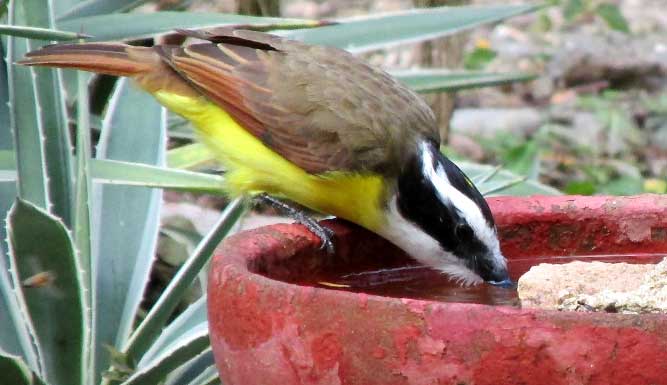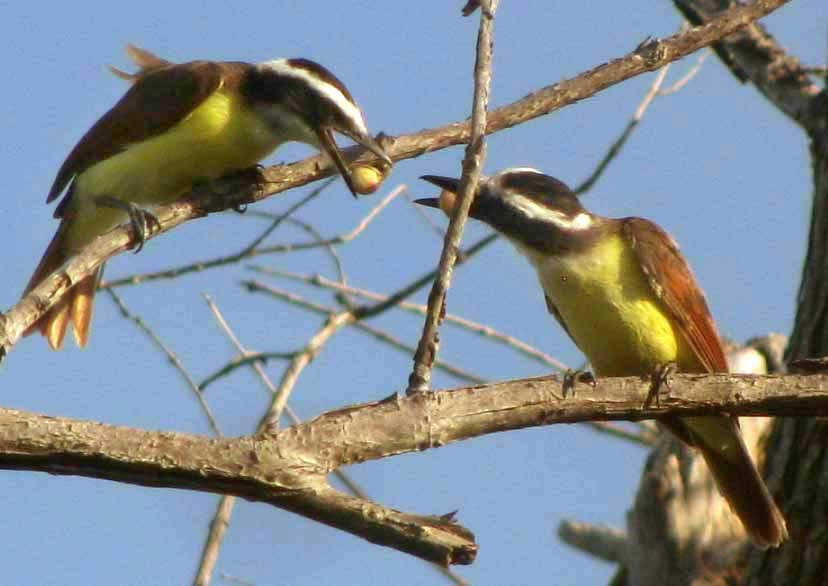
from the February 7, 2016 Newsletter issued from Hacienda Chichen Resort beside Chichén Itzá Ruins, central Yucatán, MÉXICO
THIRSTY KISKADEE
As the dry season starts to bear down the birdbath in front of the hut receives more and more daily visitors, mostly Melodious Blackbirds and Clay-colored Robins, but one Great Kiskadee Flycatcher regularly comes, shown above.
I don't know what's going on with this particular bird. Nowadays most of his kind go about calling the usual full-blown KISS-ka-DEE! calls and other raucous shrieks and general outbursts, but this one, sometimes hour after hour, for days, has been flying around calling Wahhh!, Wahhh!, and sometimes I wish he'd stop.
The birdbath is placed so I can see it from where I work at the computer in the hut, so probably as the season develops I'll have more shots like this.

from the September 25, 2011 Newsletter issued from Mayan Beach Garden Inn 20 kms north of Mahahual, Quintana Roo, México
KISKADEE MYSTERY
First, a little background: In the Yucatán we have three flycatcher species with black-and-white-striped heads, yellow underparts and brownish-gray upperparts.
There's the Boat-billed Flycatcher, the least common of the three, possessing a very broad bill and showing no reddishness in its brownish-gray upperparts. It calls with a grating, complaining EEIHRRR, EEIHRRR... Our page nicely illustrating one is found at www.backyardnature.net/yucatan/bb-fly.htm.
Similar in shape and color but much smaller, and with a much smaller beak proportionally, usually occurring in small flocks instead of singly or in pairs like the others, and issuing a variety of shrill, nervous-sounding calls, is the Social Flycatcher, shown at www.backyardnature.net/yucatan/social-f.htm.
In small towns and villages and on ranches the most typical of the three look-alike species is the American-Robin-size Great Kiskadee, PITANGUS SULPHURATUS. You know you have a Kiskadee mostly because it loudly and shrilly calls kis-k'-DEEEE, kis- k'-DEEEE. Also, in good light its wings and tail display a bit of rustiness. Of the three species, here I've only seen Great Kiskadees, though up at Hacienda Chichen they were the rarest of the three species. Now look at two of our beach Great Kiskadees shown at the top of this page.
What on Earth are they doing? Certain bird species pass food back and forth but I've not heard of Kiskadees or their relatives (they're flycatchers) doing it. Also, if they're exchanging seeds, how does it work with both birds holding seeds? With my poor vision I couldn't see what happened after the picture was snapped. I'm guessing that they are Gumbo-Limbo seeds.
Notice that the bird on the left seems to be in the process of dropping the seed, since its beak is open beyond the width of the seed. Maybe both birds are regurgitating seeds? Both seeds appear devoid of flesh.
If anyone has insight into what the birds are doing, let me know so I can tag this photo for search engines. I think we've blundered onto a very interesting picture.
adapted from Jim Conrad's online book A Birding Trip through Mexico, this excerpt from "Around the Ruins of Palenque" in northern Chiapas state
A car crashes into a dragonfly, leaving the shattered insect on the road. A stocky, yellow-bellied, dark-rusty-backed flycatcher, a Great Kiskadee, shoots from the roadside thicket, snatches up the meal, returns to a shadowy perch and eats.
Through the binoculars I admire the bird's colors and fine features. It's a very common bird, a "weed bird" distributed in disturbed sites from southern Texas to Argentina. Hearing another car coming, the kiskadee's body language shows that the bird is paying attention. He holds his head so that his right eye faces the road. The car passes, no insect is left on the road, and the kiskadee "loosens up," changes position, looks around -- until the next car, and then the same routine is repeated, with his right eye fixed hard on the road.
After three cars pass he very vigorously, almost brusquely, wipes his bill and looks around. Anyone not ashamed of interpreting bird behavior anthropomorphically would say that this bird is frustrated because not every car leaves behind a shattered dragonfly.